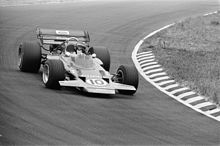
Karl Jochen Rindt was a German-born racing driver who competed with an Austrian license during his career, despite having German and not Austrian citizenship. In 1970, he was killed during practice for the Italian Grand Prix and became the only driver to be posthumously awarded the Formula One World Drivers' Championship.
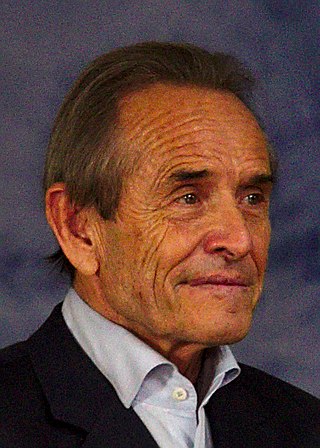
Jacques Bernard Edmon Martin Henry "Jacky" Ickx is a Belgian former racing driver who won the 24 Hours of Le Mans six times and achieved eight wins and 25 podium finishes in Formula One. He greatly contributed to several World Championships for Makes and World Sports Car championships: Ford (1968), Ferrari (1972), Porsche (1976–1977) and (1982–1985) by his 37 major World Sports Car wins. He also won the Can-Am Championship in 1979 and the 1983 Paris–Dakar Rally.

The 1969 Gran Premio de Mexico was a Formula One motor race held at the Ciudad Deportiva Magdalena Mixhuca, Mexico City on October 19, 1969, two weeks after the United States Grand Prix at Watkins Glen. It was race 11 of 11 in both the 1969 World Championship of Drivers and the 1969 International Cup for Formula One Manufacturers. The 65-lap race was won by McLaren driver Denny Hulme after he started from fourth position. Jacky Ickx finished second for the Brabham team and his teammate Jack Brabham came in third.

The 1970 Dutch Grand Prix was a Formula One motor race held at Zandvoort on June 21, 1970. It was race 5 of 13 in both the 1970 World Championship of Drivers and the 1970 International Cup for Formula One Manufacturers. This race was held the same day as the 1970 FIFA World Cup Final in Mexico City, Mexico, but that event took place later in the day from this Grand Prix.
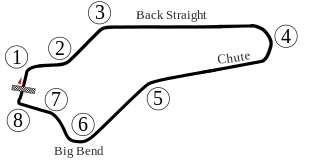
The 1970 United States Grand Prix was a Formula One motor race held on October 4, 1970 at the Watkins Glen Grand Prix Race Course in Watkins Glen, New York. It was race 12 of 13 in both the 1970 World Championship of Drivers and the 1970 International Cup for Formula One Manufacturers.
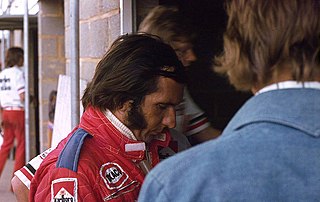
The 1972 Formula One season was the 26th season of the FIA's Formula One motor racing. It featured the 23rd World Championship of Drivers, the 15th International Cup for F1 Manufacturers and numerous non-championship Formula One races. The World Championship season commenced on 23 January and ended on 8 October after twelve races.

The 1971 Formula One season was the 25th season of the Fédération Internationale de l'Automobile's Formula One motor racing. It featured the 22nd World Championship of Drivers and the 14th International Cup for F1 Manufacturers which were contested concurrently over eleven races between 6 March and 3 October. The season also included a number of non-championship races open to Formula One cars.

The 1970 Formula One season was the 24th season of the FIA's Formula One motor racing. It featured the 21st World Championship of Drivers and the 13th International Cup for F1 Manufacturers. Thirteen races were held between 7 March and 25 October, with the Drivers' Championship won by Jochen Rindt and the Constructors' title by Lotus. Rindt died four races before the end of the season, but had earned enough World Championship points that no other driver managed to surpass his total by the end of the season. It is the only season to date in which the World Drivers' Championship title had been awarded posthumously. Jacky Ickx driving for Ferrari finished the season strongly, but his low 4th-place finish in the penultimate round ensured that Rindt's title lead would stand. In the end, all of Rindt's 45 points came from his five wins in the season.

The 1968 Formula One season was the 22nd season of the FIA's Formula One motor racing. It featured the 19th FIA World Championship, which commenced on 1 January, and ended on 3 November after twelve races, and numerous non-championship races. Graham Hill won the second of his World Championship titles, with Lotus.

The Hon.John Jeremy Miles was a British racing driver from England. He participated in 15 Formula One World Championship Grands Prix, making his debut on 6 July 1969, in the Lotus 63 4-wheel drive F1 car for which he was the official Team Lotus test driver. He scored a total of 2 championship points with a fifth place in the 1970 South African Grand Prix.
Team Lotus was the motorsport sister company of English sports car manufacturer Lotus Cars. The team ran cars in many motorsport categories including Formula One, Formula Two, Formula Ford, Formula Junior, IndyCar, and sports car racing. More than ten years after its last race, Team Lotus remained one of the most successful racing teams of all time, winning seven Formula One Constructors' titles, six Drivers' Championships, and the Indianapolis 500 in the United States between 1962 and 1978. Under the direction of founder and chief designer Colin Chapman, Lotus was responsible for many innovative and experimental developments in critical motorsport, in both technical and commercial arenas.

The Lotus 49 was a Formula One racing car designed by Colin Chapman and Maurice Philippe for the 1967 F1 season. It was designed around the Cosworth DFV engine that would power most of the Formula One grid through the 1970s. It was one of the first F1 cars to use a stressed member engine combined with a monocoque to reduce weight, with other teams adopting the concept after its success. It also pioneered the use of aerofoils to generate downforce.

The Lotus 79 is a Formula One car designed in late 1977 by Colin Chapman, Geoff Aldridge, Martin Ogilvie, Tony Rudd, Tony Southgate and Peter Wright of Lotus. The Lotus 79 was the first F1 car to take full advantage of ground effects aerodynamics.

The McLaren M23 was a Formula One racing car designed by Gordon Coppuck, with input from John Barnard, and built by the McLaren team. It was a development of the McLaren M16 Indianapolis 500 car. A Ford Cosworth DFV engine was used, which was prepared by specialist tuning company Nicholson-McLaren Engines. This helped push the DFV's horsepower output to around 490 bhp.
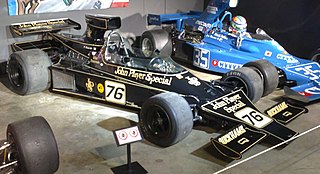
The Lotus 76 is a Formula One car designed by Colin Chapman, Tony Rudd and Ralph Bellamy and used by Team Lotus in the 1974 Formula One season.

The Ferrari 312B is a Formula One racing car designed and built by Scuderia Ferrari. It was the successor to the Ferrari 312 and was used from 1970 until early 1975. The original 312B was developed into the 312B2 and 312B3.
Four-wheel drive (4WD) has only been tried a handful of times in Formula One. In the World Championship era since 1950, only eight such cars are known to have been built.

The March 701 is a Formula One racing car model, designed by Robin Herd with Peter Wright, and built by March Engineering. The 701 was March's first Formula One design – following their one-off March 693P Formula Three prototype of 1969 – and was designed and built in only three months. The March 701 made its race debut a month after its public unveiling, at the 1970 South African Grand Prix. In total, eleven 701s were constructed, with March supplying many privateer entrants as well as their own works team. The 701's career started well, March drivers taking three wins and three pole positions from the car's first four race entries, but lack of development through the 1970 Formula One season resulted in increasingly poor results as the year wore on. The 701 was superseded by the March 711 in 1971, and made its last World Championship race appearance at the 1971 Italian Grand Prix.

The Hesketh 308C was a Formula One racing car designed by Harvey Postlethwaite and used by Hesketh Racing in the latter stages of the 1975 Formula One season. The car featured the rubber suspension which Postlethwaite had pioneered on the preceding 308B model and a Ford-Cosworth DFV engine. In 1976, the car was acquired by Wolf–Williams Racing and rebranded as the Wolf–Williams FW05.

